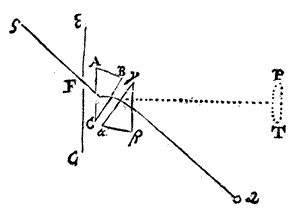Some Experiments propos'd in relation to Mr. Newton's Theory of light … together with the Observations made thereupon by the Author of that Theory
Some Experiments propos'd in relation to Mr. Newtons Theory of light, printed in Numb. 80; together with the Observations made thereupon by the Author of that Theory; communicated in a Letter of his from Cambridge, April 13. 1672.
I. TO contract beams of the Sun without the hole of the window, and to place the prism between the focus of the Lens and the hole, spoken of in M. Newtons theory of light,
<4060>II. To cover over both Ends of the Prism with paper at several distances from the middle; or with moveable rings, to see, how that will vary or divide the length of the figure, insisted upon in the said Theory.
III. To move the Prism so, as the End may turn about the middle being steady.
IV. To move the prism by shoving it, till first the one side, than the midle, than the other side pass over the hole, observing the same Parallelism.
The Observations, made upon these proposals.
I Suppose the design of the Proposer of these Experiments is, to have their events expressed, with such observations as may occur concerning them. 1. Touching the first, I have observ'd, that the Solar image falling on a paper placed at the focus of the Lens, was by the interposed Prism drawn out in length proportional to the Prisms reflexion or distance from that focus. And the chief observable here, which I remember, was, that the Streight edges of the oblong image were distincter than they would have been without the Lens.
Considering that the rays coming from the Planet Venus are much less inclined one to another, than those, which come from the opposite parts of the Suns disque; I once tryed an experiment or two with her light. And to make it sufficiently strong, I found it necessary to collect it first by a broad lens, and then interposing a Prism between the lens and its focus at such distance, that all the light might pass through the Prism; I found the focus, which before appeared like a lucid point, to be drawn out into a long splendid line by the Prisms reflexion. I have sometimes designed to try, how a fixt Star, seen through a long Telescope, would appear by interposing a Prism between the Telescope and my eye. But by the appearance of Venus, viewed with my naked eye through a Prism, I presage the event.
2. Concerning the second experiment, I have occasionally observed, that by covering both ends of the Prism with Paper at several distances from the midle, the breadth of the Solar image will be increased or diminished as much, as is the aperture of the Prism without any variation of the length: Or, if the aperture be augmented on all sides, the image on all sides will be so much and no more augmented.
3. Of the third experiment I have occasion to speak in my answer to another person; where you'l find the effects of two Prisms in all cross positions of one to another described. But if one Prism alone be turned about, the coloured image will only be translated from place to place, describing a circle or some other Conick Section on the wall, on which it is projected, without suffering any alteration in its shape, unless such as may arise from the obliquity of the wall or casual change of the Prisms obliquity to the Suns rays.
4. The effect of the fourth experiment I have already insinuated telling you (in pag. 3076 of the Transactions) that Light, passing through parts of the Prism of divers thicknesses, did still exhibit the same Phænomena.
Note, that the long axes of the two Prisms in the experiment described in the said pag. 3076 of the Transactions, were parallel one to another. And for the rest of their position, you will  best apprehend it by this Scheme; where let EG design the window; F the hole in it, through which the light arrives at the Prisms; ABC the first Prism, which refracts the light towards PT, painting there the colour in an oblong form; and αβγ the second Prism, which refracts back again the rays to Q where the long image PT is contracted into a round one.
best apprehend it by this Scheme; where let EG design the window; F the hole in it, through which the light arrives at the Prisms; ABC the first Prism, which refracts the light towards PT, painting there the colour in an oblong form; and αβγ the second Prism, which refracts back again the rays to Q where the long image PT is contracted into a round one.
The plane αγ to BC, and βγ to AC, I suppose parallel, that the rays may be equally refracted contrary ways in both Prisms. And the Prisms must be placed very near to one another; For if their distance be so great, that colours begin to appear in the light before its incidence on the second Prism, those colours will not be destroyed by the contrary refractions of that Prism.
These things being observed, the round image Q will appear of the same bigness, which it doth when both the Prisms are taken away, that the light may pass directly towards Q from the hole without any refraction at all. And its diameter will equal the breadth of the long image PT, if those images be equally distant from the Prisms.
If an accurate consideration of these refractions be designed, it is convenient, that a Lens be placed in the hole F, or immediately after the Prisms, so that its focus be at the image Q or PT. For, thereby the Perimeter of the image Q and the straight sides of the image PT will become much better defined than otherwise.
